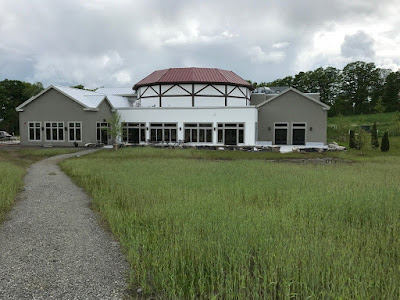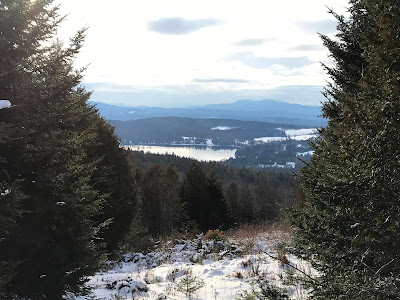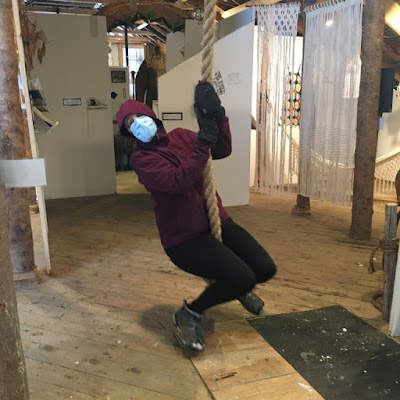We celebrated New Year's Day this year with adventures in Vermont's Northeast Kingdom. Yes, there is plenty to see and do right here in northern Vermont, even in the midst of a pandemic lockdown and even in winter – without skiing.
Friday, January 1, 2021
Northeast Kingdom Adventures
We celebrated New Year's Day this year with adventures in Vermont's Northeast Kingdom. Yes, there is plenty to see and do right here in northern Vermont, even in the midst of a pandemic lockdown and even in winter – without skiing.
NEK Odds and Ends
Our Northeast Kingdom Adventures today took us on many back roads with interesting sights. The marker above is on Lake Shore Road on the west side of Caspian Lake in Greensboro:
1781
Near This Spot By A
BLOCK HOUSE
Guarding
HAZEN ROAD
Two Scouts
CONSTANT BLISS
and
MOSES SLEEPER
Were Killed By Indians
And Buried Where They Fell
Lest We Forget The Pioneers
This Memorial Was Erected
1941
"Hazen Road," usually called the Bayley-Hazen Road, was a military road constructed during the Revolutionary War in what is now northern Vermont. This 2017 article in the Burlington Free Press has more background about the monument above: Search for the Greensboro blockhouse.
Our travels took us by several interesting agricultural enterprises including Kingdom Creamery in Hardwick, Shat Acres Highland Cattle in Greensboro, Pete's Greens in Craftsbury, and the modern (2015) hay drying operation of Jasper Hill Farm. Jasper Hill Farm makes award-winning cheeses at their farm in Greensboro and at the Center for an Agricultural Economy in Hardwick; the hay drying facility is in Craftsbury. Dry hay is critical to the flavor of their cheeses, three of which are named Bayley Hazen Blue, Moses Sleeper, and Constant Bliss (not currently in production).
Hardwick, where we entered the Northeast Kingdom on today's tour, was once known as the "Building Granite Center of the World." That industry died out about a century ago and the town declined for a time, but:
Over the past few years, Hardwick, Vermont, a typical hardscrabble farming community of 3,000 residents, has jump-started its economy and redefined its self-image through a local, self-sustaining food system unlike anything else in America.
Source: the description at Amazon.com for the 2011 book The Town That Food Saved by Ben Hewitt. Some of the businesses mentioned above are discussed in this book.
We drove by this sign in Hardwick:
The sign says: "The Highfields Institute / West Hill Farm / Compost Demonstration & Research Site / Promoting On-Farm Composting." The Highfields Institute, later the Highfields Center for Composting, is also written up in Ben Hewitt's book The Town That Food Saved, but the organization was dissolved in 2014.
We also drove by something that one does not expect to see in rural Vermont: a $14 million theater in Greensboro modeled on the Globe Theatre in London:
Northeast Kingdom Adventures: Follow the link for the introductory post about this series and a list of all the posts in the series.
Barr Hill Natural Area
Barr Hill overlooks Caspian Lake in Greensboro, Vermont. We hiked most of the yellow trails on Barr Hill today, enjoying the overlooks in all directions, and some of the black trails including the Mossy Trail (see trail map below, click on the image to enlarge):
The photo at the top of this post is looking southwest. The view below is looking northwest; Belvidere Mountain is on the horizon near the center of the photo.
The Barr Hill Natural Area consists of 256 acres owned and managed by The Nature Conservancy in Vermont. The trails there connect to the trails at the Highland Lodge on Caspian Lake and the extensive trail system at the Craftsbury Outdoor Center.
Barr Hill Gin and Barr Hill Vodka, made by Caledonia Spirits, are named for Barr Hill in Greensboro. Click here for that story.
Northeast Kingdom Adventures: Follow the link for the introductory post about this series and a list of all the posts in the series.
Museum of Everyday Life
The Museum of Everyday Life is on Dry Pond Road (aka Vermont Route 16) in Glover just north of the rest stop and picnic area for Runaway Pond. We were the first visitors to sign the guest book in 2021. The signs said to turn the lights on when entering, turn them off when leaving, wear a face mask and use the hand sanitizer during the COVID-19 pandemic, and consider leaving a donation.
The main exhibit in this museum is about a single theme, something in ordinary life, and the theme changes annually. The current exhibition is about knots. Previous exhibitions have been about scissors, mirrors, matches, dust, and many other things. The museum includes selected items from previous exhibitions.
Once you start thinking about knots, they are everywhere! Below I am looking at the exhibit on different ways to tie a necktie.
Hanging from the rafters was a rope swing with a huge knot at the bottom to sit on. We all enjoyed that! Here Nancy takes a turn:
The Museum of Everyday Life is in an old, unheated barn, hence the winter clothes. We did not see anyone else during our visit.
The museum's website is a rich, fascinating source of information. The Philosophy Department provides insight into what the museum is all about. The News page lists media articles about the museum, including this March 2019 article in the New York Times.
Northeast Kingdom Adventures: Follow the link for the introductory post about this series and a list of all the posts in the series.
Runaway Pond
Vermont State Route 16 north of the Greensboro-Glover town line is also known as Dry Pond Road. Five miles south of Glover is the rest stop and picnic area shown above. The historic marker tells the story:
RUNAWAY POND
On this site, on June 6, 1810 settlers dug an outlet to the north from what was then known as Long Pond. The retaining bank collapsed, causing all water from the 1.5-mile long pond to be discharged toward Barton River, and on to Lake Memphremagog, with extensive damage to the countryside, but no loss of life.
The plaque in the photo below adds more details:
LONG POND / RUNAWAY POND / DRY POND
In 1810 the water level of Long Pond was 70 feet above this marker and the water flowed south into Greensboro and the Lamoille River.
Needing more water to power Aaron Willson's grist mill in Glover, 60 men and boys dug a ditch on the north shore (about .5 miles north of here) to cause the water to flow into the Glover/Barton River.
Due to the quicksand in the earth, the entire hillside washed away and the pond "ran-a-way" discharging its billion gallons of water toward the mill in 1.5 hours.
Spencer Chamberlin raced ahead of the wall of water for 5 miles and saved the miller's wife.
Glover Historical Society 1996
It was thought-provoking to stand at that picnic area, look at the steep hillsides surrounding the narrow valley, and contemplate how they once contained a 70-foot deep pond that drained in just 1.5 hours.
Northeast Kingdom Adventures: Follow the link for the introductory post about this series and a list of all the posts in the series.
Camp Wapanacki
- by the current owners
- by the New York Institute for Special Education
- the New York Times obituary for Dr. Frampton













